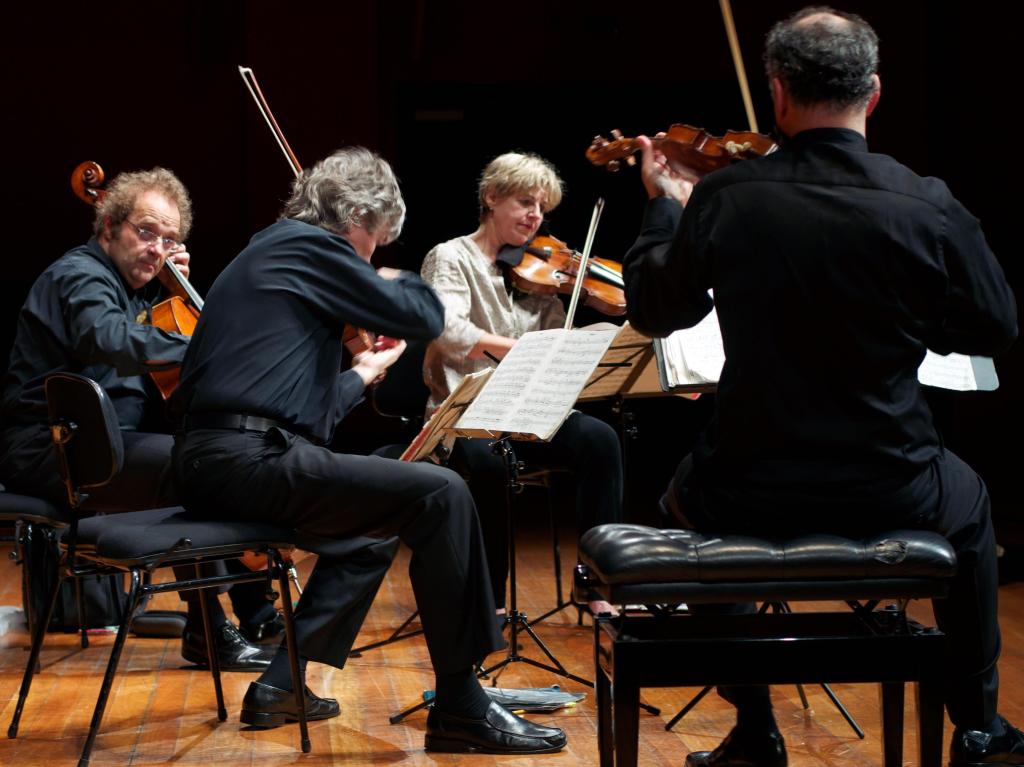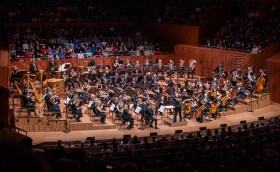Image of Takács Quartet via Musica Viva.
The genre of the string quartet is generally admitted to be the most enduring, adaptable and valuable in all chamber music. Here was an occasion to hear one of the world’s finest quartets. An ensemble such as this shows its maturity from the moment it starts playing, with a telling mixture of subtlety of phrasing, a close focus on the smallest of details, perfect rapport, excellent intonation and a further magical component of flexible syntax and expression that perhaps even the musicians concerned do not fully comprehend or are able to fully harness. The effect is a highly eloquent conversation in music by four separate musicians playing simultaneously. Two members of the quartet (the second violin and cello) are the original members of this quartet formed at the Franz Liszt Academy in Budapest in 1975. The printed program commented that they have been playing together for 42 years and miraculously are still on speaking terms.
Three very different works were presented on Saturday night in Elisabeth Murdoch Hall in Melbourne. Joseph Haydn’s String Quartet in F major, Op 77 No 2 Hob III:82 Lobkowitz, composed in 1799, was followed by a new work by Australian composer Carl Vine. His String Quartet No 6 Child’s Play was composed this year as a joint commission for Musica Viva Australia with support from Michael and Frédérique Katz, The Seattle Commissioning Club, and Carnegie Hall. Finally we heard Ludwig van Beethoven’s late and game-changing String Quartet No 12 in E flat major, Op 127.
The Allegro moderato of Haydn’s quartet sang with all the sunny, golden optimism and confidence of a composer at the peak of his career. Fulsome expression and articulate wit were abundant throughout. The rustic dance-like Menuetto: Presto ma non troppo delighted for its liveliness with mischievous rhythmic displacements. The Trio by contrast was mellifluous and warmly delivered. The Andante that plays with duos within the ensemble had the perfect, unhurried gait of a pleasant country stroll. The Finale: Vivace assai pleased for its quick intelligence and boundless energy.
This is the Takács Quartet’s ninth tour of Australia for Musica Viva and since its visit in 2004 it has each time played a quartet by Musica Viva’s artistic director, Carl Vine. His 6th String Quartet here receiving its first performances, is a construction of five touching tableaux each expressing different aspects of childhood. The opening Play has a reflective start, but soon bursts into rhythmic liveliness, cheekiness and fun. Vine’s music mostly has a tonal centre but that can rapidly and surprisingly shift course. Concentration is harsh and intense as it holds up ideas with forceful singularity, its subject being a child studying an ant. The central Friendship movement is all about joining in play and imitation. Fragmented melodic material became shared and developed. It all ran out of puff in its final bars before Sleep provided a much-needed afternoon nap in drifting tremolando clouds and lullaby-lyrical viola and cello solos. Finally restored to full energy levels Running is all care-free verve in infectious enthusiasm. A coda speeds everything up towards a final joyous tumble. I enjoyed this work for its singular and effective ideas unconstrained by traditional form and the authentic and innovative subject matter.
Beethoven’s 16 string quartets have become the ensemble’s special focus as they last year completed 6-concert Beethoven quartet cycles in London’s Wigmore Hall, at Princeton, the University of Michigan, and at UC Berkeley. The first of what are called Beethoven’s ‘late’ quartets, Op 127 takes the genre of the string quartet to new territory. The components that Haydn might have used in his musical dialogue are all there, but with Beethoven these building blocks become equivocal, fluctuating and mercurial. Form and structure while present are less clearly articulated. The work mystified its first audiences with ideas that intersect, wax and wane with fluidity and great complexity. The Takács Quartet’s interpretation was refreshingly novel, with a heightened sense of deep awareness of the subtlest of meanings. The work flowed with focus and without any break in rhetoric, the tell-tale sign of less mature readings. The lengthy second movement, presented especially fine playing.
4 1/2 stars out of 5
Takács Quartet
Edward Dusinberre, violin
Károly Schranz, violin
Geraldine Walther, viola
András Fejér, cello
Presented by Musica Viva Australia
Saturday, 12 August, 2017
Elisabeth Murdoch Hall, Melbourne Recital Centre





